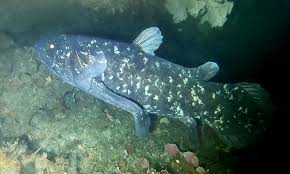Coelacanth:

Paleontologists in China have described a new species of the coelacanth genus Whiteia on the basis of two fossilized specimens.
- The Coelacanth is a prehistoric, lobe-finned fish (belonging to the order Coelacanthiformes) that was once thought to be extinct for about 66 million years, until it was rediscovered alive in 1938 off the coast of South Africa.
- It is often called a “living fossil”.
- The earliest coelacanth fossils date back as far as the Devonian period, approximately 420 mya.
- At one time coelacanths were a large group comprising about 90 valid species that were distributed worldwide in both marine and freshwaters.
- At present, there are two living species of coelacanth, the West Indian Ocean coelacanth and the Indonesian coelacanth.
- These fish live in deep saltwater environments and can grow to be nearly 2 meters long.
- They have fleshy, limb-like fins that are internally supported by bone.
- Their fins are also paired and move in a synchronized pattern similar to four-limbed animals.
- As one of the last lobe-finned fish, coelacanths have numerous characteristics unique among living fish.
- Among them is the presence of a special electrosensory organ in the snout called the “rostral organ.”
- This organ is filled with a gel and enables the coelacanth to sense low-frequency electrical signals and “see” in the dark.
- Another is a joint or “hinge” in the skull that allows the front portion of the braincase to swing upwards, greatly enlarging the gape of the mouth.




